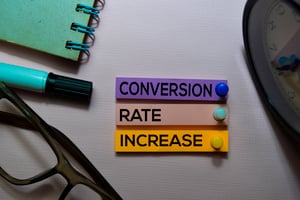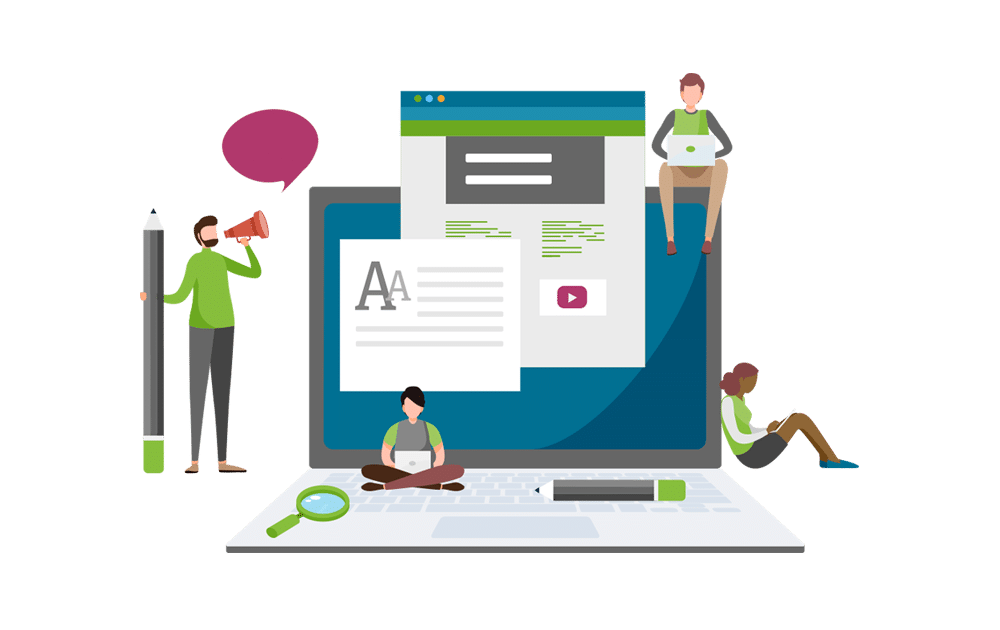Increased website visits and traffic mean nothing if nothing happens. If your organic or paid media landing pages are getting hits but not making sales, then you need some help in the conversion rate optimization (CRO) department. It’s not hard to turn those website visitors into paying customers. Learn how with these conversion rate optimization best practices for 2020.

What’s conversion rate optimization?
CRO is the process of using marketing analytics to increase the number of visitors that take action or convert on your organic or paid media landing pages. In most cases, that means turning those visitors into paying customers. Sometimes it means converting a visitor into a subscriber. It depends on the goal or purpose of your landing page.
Conversion rates are calculated by the number of conversions divided by the number of visitors to your page and is given as percentage. For example, if 10 out 100 visitors to your landing page converted or took action then you would have a 10% conversion rate. Think of your landing page as a storefront. Many will enter. Most will browse. Some will buy. In most cases, the overall strategy behind conversion rate optimization best practices is to give visitors more reasons and opportunities to say yes to your offer.
Having accurate data and being able to analyze that data is critical for improving your conversion rates. Below are some metrics you should consider when deploying CRO best practices:
- Unique visitors
- Pageviews
- Bounce rates
- Devices
- Abandonment Rate
- Page load times (faster is better)
- User experience or UX
- Number of customers
- CPC or ROI
- Demographics
- Current conversion rates
So, why is CRO important? More conversions typically equal more sales. Your business will potentially become more profitable with higher conversion rates. Let’s get into some conversion rate optimization best practices below.
1. Identify your buyer persona or target customer.
You want to design your landing page with your buyer persona in mind. It’s critical that before you do anything else on this list, that you accurately identify who that person is — and isn’t. You can’t say the right thing to the wrong person. Make your landing page’s offer so compelling that the target customer who visits it can’t refuse.
Maybe you’re unsure of how to figure out precisely what your target customer wants. So, what can you do? Ask them. Create a survey or poll for your audience. You can distribute the survey to your email list or create a sticky post on Facebook. Keep the questions short and concise and stick to ten questions or fewer. You can also look into the current demographic information in your Google Analytics account of users already visiting and converting on your site to pinpoint your target customer.
2. Analyze and track your data.
Those metrics we mentioned earlier? Start using them. When you track your data, you’ll get insight into your website visitors’ behavior and how they are interacting with your landing page. Google Analytics is a free tool you can use for analyzing and tracking website data. Once you have access to the data, don’t guess on how to optimize your landing page. Use the information you have to make informed decisions for optimization.
3. Use an intuitive, guided layout.
Remember that the spirit of CRO for landing pages is giving your visitors enough chances and opportunities to say yes to your offer. When crafting and optimizing your landing page, be sure to use a layout that helps guide the visitor to the proper destination. Be deliberate with where you place the call-to-action (CTA), navigation panels, arrows, or other components. Also, your landing page should display messaging that matches the copy and headlines or phrases used in your ads that link visitors to the page. This is referred to as message match and ties in with enhancing the user experience, which will help optimize conversion rates. Weak message match can confuse visitors and increase bounce rates because visitors feel like they haven’t come to the right place.
4. Reduce and remove friction.
Friction is when elements on your landing page give the visitor pause or otherwise promote their objections. Fewer instances of friction will improve the user experience (UX). It’s possible to analyze and determine the UX of your landing page through screen recordings, heat maps, and surveys.
An example of friction could be a paragraph of copy that looks like a wall of text. Remove it if possible, or convert the paragraph into easy-to-digest bullet points. Having too many CTAs is also a source of friction. Keep your offer to one compelling CTA. Otherwise, you can confuse website visitors and harm conversion rates. Forms on a landing page can also be a big source of friction. Too many fields can lower UX and conversion rates.
 Slow page speed loads also increase friction and lower the UX. The probability of someone leaving your landing page increases 32% if the page load time goes from one second to three seconds. If you’re unsure of how long your page is taking to load, you can test page load times with a free Google speed test. Ideal page load times are two seconds or faster. Faster page load times also increase your Google ranking.
Slow page speed loads also increase friction and lower the UX. The probability of someone leaving your landing page increases 32% if the page load time goes from one second to three seconds. If you’re unsure of how long your page is taking to load, you can test page load times with a free Google speed test. Ideal page load times are two seconds or faster. Faster page load times also increase your Google ranking.
So, what does this mean for CRO? The bottom line is you need to remove any instances of friction on your landing page and improve page load times.
5. Use A/B split tests to create the perfect landing page.
Your data and the information you have on your buyer persona may give you a good insight into how to design your landing page and present your offer. But, without A/B split tests, you’re still just guessing. A/B split testing your pages is critical to conversion rate optimization best practices. A few examples of things you should test are:
- Layout
- Form Design
- CTA language
- CTA button colors
- Headline
- Images (Quality images - avoid stock if you can!)
- Body copy
- Font colors, styles, and sizes
A/B split testing different elements on your landing page will increase your confidence since you won’t be guessing if this or that change will work. Testing enables you to create the perfect, optimized page.
A few examples of common A/B split tests are testing the copywriting of the landing page. Using different testimonials that provide instances of social proof can increase visitor trust. But you won’t know which testimonial is most effective unless you test the copy. Also, changing the position of the main CTA button on a landing page is a common way to test the effectiveness of the page .The general rule of thumb is that the CTA should be placed above the fold. But can you know for sure unless you perform an A/B split test?

Here at FoundSM, we are always conducting experiments on our landing pages. For one of our clients with multiple form fields, we tested splitting it into two long steps on one page against another page with three shorter steps. The result? The page with two long steps showed a lift of 149.02%.
But improving the health and profits of your business doesn’t end with CRO. Depending on the offer, what happens after someone hits the CTA button on your landing page is just as important.
Conversion Rate Optimization Best Practices: The Bottom Line
The rules for CRO and landing page optimization are to never guess and to use data to guide your decisions and make the perfect landing page. Designing the landing page with your ideal customer’s needs and goals in mind, along with a reduction in friction, will help you increase sales. A/B split testing is the key to conversion rate optimization. Having access to granular data won’t do you much good if you resort to guessing.
At Found Search Marketing, we use Unbounce to create the perfect landing pages for our clients. We use robust A/B split testing tools, taking the guesswork out of landing page design and optimization. Contact us today for a free consultation. We’ll turn your landing page into a well-oiled marketing and sales machine.
You May Also Like
These Related Stories

How to Increase Your Organic Search Rankings In 7 Easy Steps

A Guide to Using Paid Search for Top of Funnel Marketing



No Comments Yet
Let us know what you think